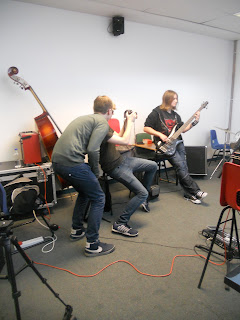 We brought the equipment which included a laptop (for offloading data onto), my camera (plus an SD card), tripod and dolly. We planned to start filming at 10:30 in the music block at the college, but one of the band members didn't show up until after 11, so we took some time to get some shots of the room. To make the time more productive, we asked the present band members to set up their equipment and start playing the song, we could film each band member individually to give us more footage for the video.
We brought the equipment which included a laptop (for offloading data onto), my camera (plus an SD card), tripod and dolly. We planned to start filming at 10:30 in the music block at the college, but one of the band members didn't show up until after 11, so we took some time to get some shots of the room. To make the time more productive, we asked the present band members to set up their equipment and start playing the song, we could film each band member individually to give us more footage for the video.Our setting was particularly bland, but that was a consequence of running out of time to find a band and organize early on. Beyond filming the entire performance somewhere else (not an option at this point), we could perhaps add a narrative or a story-line to cut between during the performance (which was also unlikely given the time restraints). The band knew the song and were able to play it from start to finish, they played the song several times and as we filmed it from a variety of angles.
Whilst filming, I acted as the cameraman. I was in charge of ensuring we got a good set of shots and effective camera angles that made the scene look more interesting. I also was in charge of using the equipment such as the trip-pod and dolly which I combined to get some interesting moving shots. I was chosen for this role mainly because I was most familiar with the camera we used which requires a lot of manual setting changes in order for the video to look good. I changed the video quality to be 720p which is high definition (1280x720), this makes the video lower quality than full HD 1080p (1920x1080) but of smaller file size and of higher frame-rate.
File size for the video was an important variable to consider as it allows us to fill up our small SD card (which is roughly 8Gb) with more video than if we used full HD, which translates to less time spent offloading the video onto the laptop (to allow for more space on the SD card to film) and less time editing later on (larger video files with higher definitions take longer to load and edit on the computer). Halfway through our session the camera's memory filled up and we had to offload all the video data onto the laptop we had at hand; this was frustrating because the laptop was slow and this took 10 minutes or so which was precious time we could have spent filming before we had to leave. This could have been solved by using a larger SD card such as 16GB or 32GB instead of 8GB. Battery power wasn't a concern as I had fully charged it before the shoot, but ideally I should have brought extra batteries in-case we ran out of power.

We got the band to play the song 6~ times, with three of those spent filming the band directly from the front, from the right side and from the left side. With the other takes I moved around the room to film band members from different angles and more obsqure positions such as from the floor looking up. I'm satisfied with the shots, but I can't help but feel we were cut-off by the 12:00pm deadline we had to clear out the room; I think there was more we could have filmed and from more angles and positions. Having more footage would have made the edit more interesting which is something we need to compensate for the lake of narrative or variety of the performance.
Doug was in charge of directing the shoot. He got the band to preform when we wanted to and re-arranged them around the room to get the ideal set-up. For example, he arranged the band members to walk into the room and allowed for me to film them doing so, giving us a shot to use for the introduction of the music video. Holly was with us as well, taking photos of us working and of the band preforming to use as evidence for the write-up and for the paperwork we've been creating detailing our process. She was also assisting us by ensuring all of the equipment was ready to be used and went to Steve's classroom to pickup the laptop and dolly. Unfortunately Dan was not available as he was ill.
Once we were done with the shooting, we offloaded all of the footage onto the laptop to ensure we had a copy of all the footage. Seeing as Post's schedule is more flexible than Forest's, we should be able to get in contact and film something more in-case we don't have enough footage to edit with. Strangely though, Post don't have a recorded version of the music they had been preforming (something you could listen to on a computer). We've asked them to record a version for us, as our task for the music video is to lip-sync the footage with a soundtrack, which obviously isn't possible if there's nothing to use. Hopefully we'll get the recorded version soon enough so we can start editing.
































